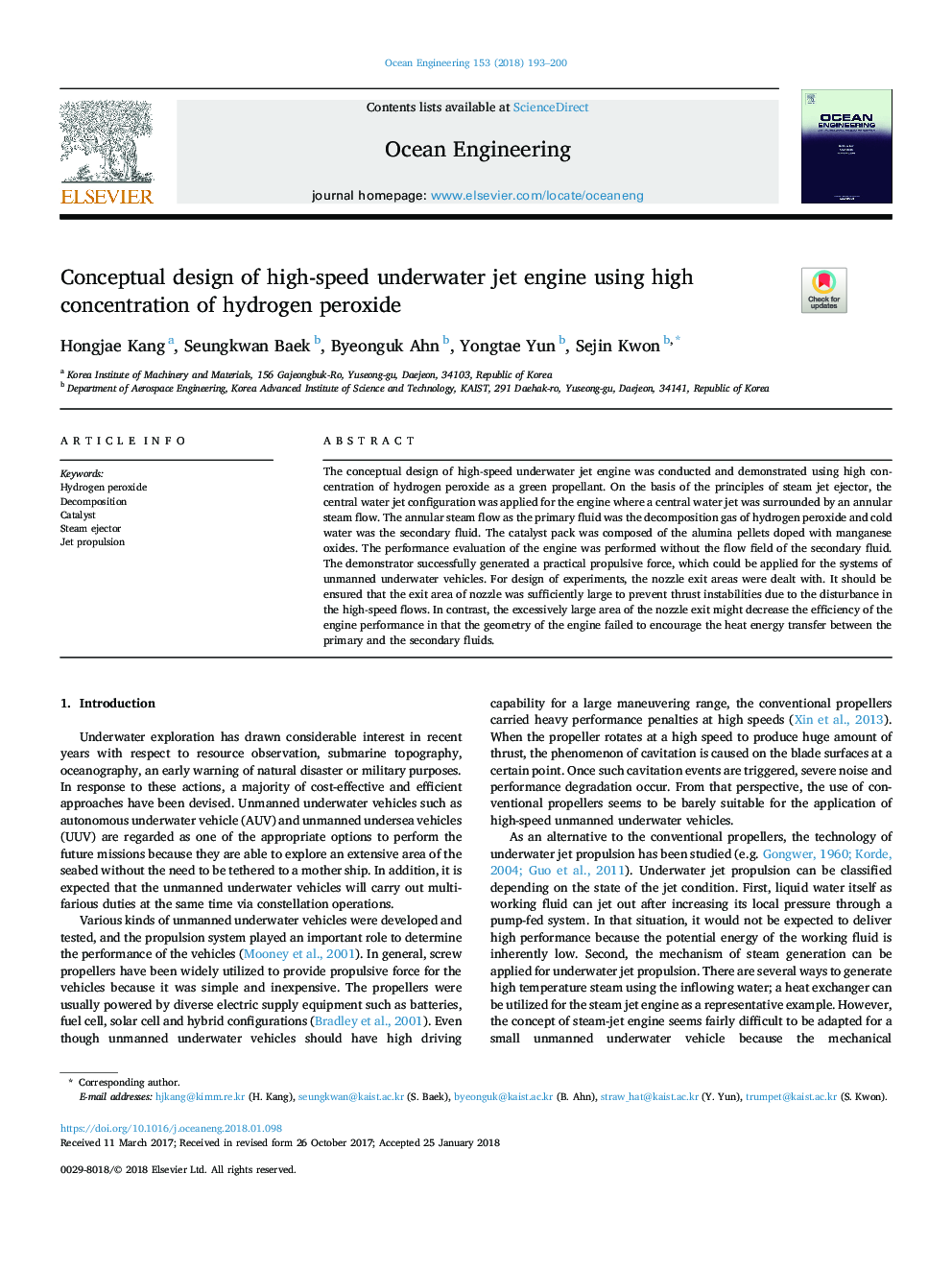| کد مقاله | کد نشریه | سال انتشار | مقاله انگلیسی | نسخه تمام متن |
|---|---|---|---|---|
| 8063079 | 1520637 | 2018 | 8 صفحه PDF | دانلود رایگان |
عنوان انگلیسی مقاله ISI
Conceptual design of high-speed underwater jet engine using high concentration of hydrogen peroxide
ترجمه فارسی عنوان
طراحی مفهومی موتور سرعت جرثقیل زیر آب با استفاده از غلظت بالا پراکسید هیدروژن
دانلود مقاله + سفارش ترجمه
دانلود مقاله ISI انگلیسی
رایگان برای ایرانیان
کلمات کلیدی
آب اکسیژنه، تجزیه، کاتالیزور، انژکتور بخار، نیروی دریایی،
ترجمه چکیده
طراحی مفهومی موتور سرعت جرثقیل زیر آب با استفاده از غلظت بالا پراکسید هیدروژن به عنوان یک سوخت سبز نشان داده شده است. براساس اصول جت اگزوز بخار، پیستون آب جت مرکزی برای موتور که جت آب مرکزی با یک جریان بخار حلقوی احاطه شده بود اعمال شد. جریان بخار سالم به عنوان مایع اولیه گاز تجزیه پراکسید هیدروژن بود و آب سرد مایع ثانویه بود. بسته کاتالیزور از گلوله های آلومینا که با اکسید منگنز لعابیده شده بودند تشکیل شد. ارزیابی عملکرد موتور بدون میدان جریان مایع ثانویه انجام شد. تظاهرکنندگان با موفقیت نیروی حرکتی عملی را ایجاد کردند که می تواند برای سیستم های وسایل نقلیه بدون سرنشین زیر آب استفاده شود. برای طراحی آزمایشات، مناطق خروجی نازل مورد بررسی قرار گرفتند. باید اطمینان حاصل شود که ناحیه خروجی نازل برای جلوگیری از ناپایداری های راننده به دلیل اختلال در جریان های با سرعت بالا به اندازه کافی بزرگ است. در مقابل، ناحیه بیش از حد بزرگ از خروج نازل می تواند کارایی عملکرد موتور را کاهش دهد در حالی که هندسه موتور موفق به تشویق انتقال انرژی گرمایشی بین مایعات اولیه و ثانویه نمی شود.
موضوعات مرتبط
مهندسی و علوم پایه
سایر رشته های مهندسی
مهندسی دریا (اقیانوس)
چکیده انگلیسی
The conceptual design of high-speed underwater jet engine was conducted and demonstrated using high concentration of hydrogen peroxide as a green propellant. On the basis of the principles of steam jet ejector, the central water jet configuration was applied for the engine where a central water jet was surrounded by an annular steam flow. The annular steam flow as the primary fluid was the decomposition gas of hydrogen peroxide and cold water was the secondary fluid. The catalyst pack was composed of the alumina pellets doped with manganese oxides. The performance evaluation of the engine was performed without the flow field of the secondary fluid. The demonstrator successfully generated a practical propulsive force, which could be applied for the systems of unmanned underwater vehicles. For design of experiments, the nozzle exit areas were dealt with. It should be ensured that the exit area of nozzle was sufficiently large to prevent thrust instabilities due to the disturbance in the high-speed flows. In contrast, the excessively large area of the nozzle exit might decrease the efficiency of the engine performance in that the geometry of the engine failed to encourage the heat energy transfer between the primary and the secondary fluids.
ناشر
Database: Elsevier - ScienceDirect (ساینس دایرکت)
Journal: Ocean Engineering - Volume 153, 1 April 2018, Pages 193-200
Journal: Ocean Engineering - Volume 153, 1 April 2018, Pages 193-200
نویسندگان
Hongjae Kang, Seungkwan Baek, Byeonguk Ahn, Yongtae Yun, Sejin Kwon,
